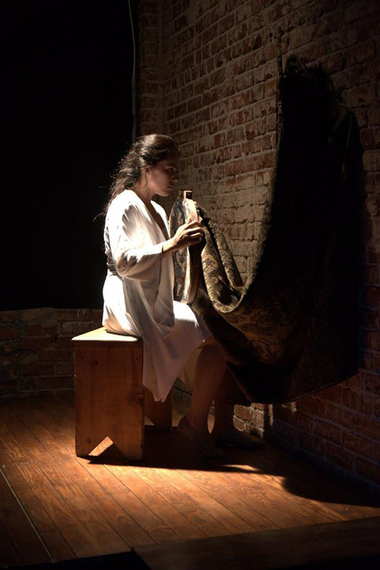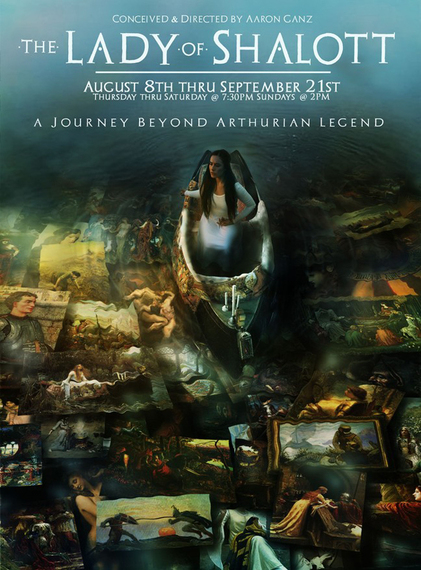Richard Wagner thought a gesamtkunstwerk, an integration of all the arts, would be the purest form of theatre. "The Lady of Shalott: A Journey Beyond Arthurian Legend," conceived and directed by Aaron Ganz for TE San Pedro Rep, grounds gesamtkunstwerk in unbelievable storytelling and enchanting spectacle. The result? A sensual and passionate example of the way art can come to life.
To appreciate the extraordinary thing Ganz and his troupe have done here, consider the bare bones of the story. He bases the production on a poem by Alfred Tennyson. Elaine, the Lady of Shalott (Cassandra Ambe) weaves at her loom. A curse prevents her from looking out onto the world. Her only knowledge of things beyond her ken is what she can see through her mirror. She's dressed in white. This shows her purity and lack of contact with humanity as well the blank slate of her life. She catches a reflection of Lancelot (Sam Fleming). When she goes to her window to watch him pass, the curse is activated. Knowing full well what awaits her, she puts herself in a boat to sail to Camelot. Along the way she dies.
Standalone, it's a dramatic story. It's full of high honor and adventure, chivalry and romance, the perfect metaphor for art. The artist as cloistered weaver, an aesthetic Sisyphus, living in a world of yearning and dreams. Then, the intrigue of reality, like the angel in the film "Wings of Desire," who becomes mortal to experience life.
But it's what San Pedro Rep does to enact the story that is memorable. To set the stage, you enter the theatre to find an art gallery, the like of which you'd find at the Metropolitan Museum of Art. A suit of mail, jewelry, and a sword, each labeled with its historical reference. And then (and then!) we see paintings on the wall. The paintings look way too genuine. Each depicts various versions of the story of the Lady of Shalott, painted by Pre-Raphaelite artists. For them the story was a fitting subject.
Having set the stage, the story begins. There are no transitions here. No dimming of the lights, no raised curtain, no momentary hushed quiet. It just begins. As with their prior production of "My Fair Lady," the drama takes place in the Theatre's three spaces: the front, the back room, and the backyard. We flow from space to space, shepherded by the characters that are as much a part of the audience as we are of the cast.
As the story unfolds, it's not as much linear as expansive. Gestures and movement are not mere gestures. They're the occasion for Dionysian dances that combine ballet and modern dance. Dialogue is not mere dialogue, it's song that ranges from ballads to the Beatles to, yes, the Bee Gees.
The story gets told. The Lady of Shalott dies. Because we've spent the better part of an evening with her, we die too. But it's the way that Ganz et al frame the production that we realize the production's narrative thoroughness. There's a Modern Girl (Paris Langle). While everyone else wears period garb, she's dressed in black. For most of the production, she reacts to the story within a story. The story begins with her looking at John William Waterhouse's Lady of Shalott painting. The Lady's story resonates with her. She breaks out in a dance of anguish. Then, in the next room, the Lady comes to life. Then, in the backyard, Camelot comes to life. The production, then, is the story of the Modern Girl's experience of the painting. The painting comes to life. Then the story behind the story comes to life.
It's a beautiful and mesmerizing balance of spectacle and storytelling. The one enhances the other. Ganz remembers theatre's main purpose: to tell a tale. He takes a simple story, a young woman's experience of a work of art. He makes that story come alive in surprising ways. With boldness and innovation, not to mention energy and intimacy. This is something special, out of the ordinary. Something that makes you impatient to see what they'll do next.
Performances are 7PM, Thursday, Friday, Saturday and 3PM, Sunday. The show runs until September 21. Tickets are $25, General Admission, and $20, Students. The Theatre is located at 311 W. 7th Street, San Pedro, CA 90731. For more information call (424) 264-5747.


